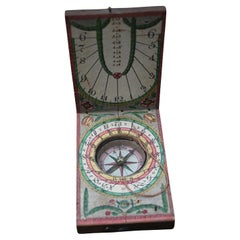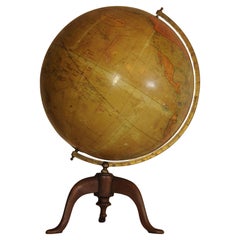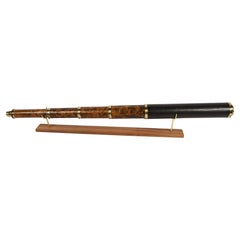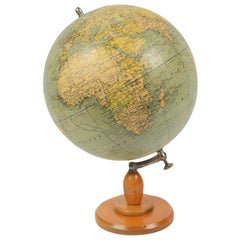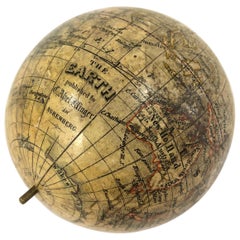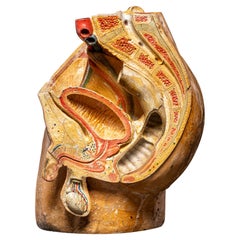Paper Scientific Instruments
to
12
128
14
142
1
17
17
14
4
4
2
2
1
20
32
90
1
38
27
7
1
8
5
5
1
3
3
7
913
662
450
254
143
121
32
22
17
17
143
143
143
4
3
3
2
2
Material: Paper
Antique 18th Century Diptych Portable Sundial And Compass by Beringer
Located in Bilzen, BE
Antique 18th Century Diptych Sundial and Compass a portable wooden sundial with compass, of German origin, by David Beringer, Nuremberg, dating back to the 1780 circa, in good age re...
Category
Late 18th Century German Louis XVI Antique Paper Scientific Instruments
Materials
Metal
Antique World Globe From Fleet Street London 1923 on Wooden Stand
Located in Reading, Berkshire
Antique Terrestrial Geographia of Fleet Street London 12"inch World Globe on handcrafted Wooden Three Legged Base 1923
Made 55 Fleet Street, London
Beautiful desktop globe, showcas...
Category
1920s British Art Deco Vintage Paper Scientific Instruments
Materials
Wood, Paper
$1,327 Sale Price
25% Off
Cardboard round section telescope with four extensions and brass ferrules
Located in Milan, IT
Rare round cardboard scope with four extensions and brass ferrules, german manufacture from the early 19th century. Excellent state of conservation.
Maximum length cm 95 - 37.4 in,...
Category
Early 19th Century Antique Paper Scientific Instruments
Materials
Paper
Antique Terrestrial Globe Published in 1940s by Girard Barrère et Thomas, Paris
Located in Milan, IT
Terrestrial globe published in the 1940s by Girard Barrère et Thomas 17, Rue de Buci Paris. Turned wooden base, papier mâché sphere covered with paper printed by engraving on copper ...
Category
1940s French Vintage Paper Scientific Instruments
Materials
Wood, Paper
19th Century German Miniature Pocket Terrestrial Globe
Located in Essex, MA
A miniature 19th century 3.5 inch diameter pocket terrestrial globe by C. Abel-Klinger, Nuremberg, Germany, in English for the English speaking markets. Signed with cartouche reading...
Category
1880s German Antique Paper Scientific Instruments
Materials
Brass
$1,230 Sale Price
50% Off
Male anatomical model in painted stuccoed fiber. First half of the 20th century.
Located in Leuven , BE
Male anatomical model in painted stuccoed fiber. First half of the 20th century. Beautiful patina. Height: 30 cm.
Category
Early 20th Century French Paper Scientific Instruments
Materials
Natural Fiber, Parchment Paper
Celestial Table Globe, Charles-François Delamarche, Paris, 1791
Located in Milano, IT
Celestial table globe
Charles-François Delamarche
Paris, 1791
It measures: 17.13 in in height, Ø max 27.7 in; the sphere Ø 7.09 in
(h 43.5 cm x Ø max 27.7 cm; the sphere Ø 18 cm).
W...
Category
1790s French Other Antique Paper Scientific Instruments
Materials
Metal
Ptolemaic Armillary Sphere, Charles-François Delamarche, Paris, ante 1798
Located in Milano, IT
Ptolemaic armillary sphere
Charles-François Delamarche
Paris, ante 1798
Wood and papier-mâché
covered with printed and partly hand-colored paper
It measures 16.37 in in height x Ø 10.94 in (41.60 cm - Ø 27.80 cm)
It weights 2.33 lb (1,058 g)
State of conservation: consistent with its age and use, the paper shows some signs of use, stains and abrasions.
The sphere is Ptolemaic, with the Earth placed at its center, surrounded by the Moon and the Sun mounted on two metal arms.
The sphere is composed of six horizontal and two vertical rings (armillae), each bearing graduations and its own name.
The first horizontal ring is illegible. The others, in descending order are: North Pole, Tropic of Cancer, Equator, Tropic of Capricorn, South Pole.
The vertical rings consist of two double meridians.
The sphere is then connected to the large meridian by two pins, a vertical ring inserted perpendicularly into the circle of the Horizon, in turn supported by four semicircles connected to the turned and black-stained wooden base.
Each element is covered with printed paper. It contains various pieces of information: latitudes, length of days, names and zodiac symbols, calendar, wind directions, etc.
The vertical circles mention the latitudes and longitudes of different cities: Rome, Bordeaux, Madrid, Boston, Batavia (Jakarta), Acapulco, etc.
Even the small terrestrial globe is covered with printed paper: continents and oceans appear with numerous geographical markings indicating the most recent explorations.
In the Pacific Ocean, west of South America bears the following inscription:
GLOBE
TERRESTRIAL
à Paris
chez Delamarche Géog
Rue du Foin Jacques
Au Collège de
M.e Gervais
The North American coasts are well delineated and California appears correctly as a peninsula - reports from Spanish explorers in the region had given rise to confusion as to whether it was connected to the mainland or not. The geographical nature of California was confirmed after the explorations of Juan Bautista de Anza (1774-1776).
Alaska is not described and is only partially traced; it would become part of the United States in 1867.
Various Pacific islands are indicated.
Australia (the name definitely used from 1824) is called "Nouvelle Hollande."
Tasmania is still represented as a peninsula and this is an important detail for the dating of our armillary sphere.
The island is separated from Australia by Bass Strait, which was crossed by Matthew Flinders for the first time in 1798, showing that it was not a peninsula. Delamarche certainly would not have waited a long time to update such an important geographical datum: presumably he did so shortly after receiving the news.
Charles-François Delamarche (1740-1817) founded his laboratory around 1770 and, in a few years, he became the most famous French cartographer and globe maker between the 18th and 19th centuries. After having acquired the laboratory of the late Didier Robert de Vaugondy (1723-1786; himself a renowned cartographer who continued the family business founded by his grandfather Nicolas Sanson in the seventeenth century) and after having purchased, between 1788 and around 1800, the businesses of Jean-Baptiste Fortin (1750-1831) and Jean Lattré (around 1750-1800), he began to call himself "Successeur de MM. Sanson and Robert de Vaugondi, Géographes du Roi and de M. Fortin, Ingénieur-mécanicien du Roi pour les globes et les sphères."
Thus, at the end of the eighteenth century, Delamarche possessed the warehouse stocks, as well as the manufacturing skills of the globes of his main rivals in Paris.
In addition to this aggressive acquisition policy, the key to its success also lay in the combination of high-quality cartography combined with extremely attractive globes and armillary spheres; and, of course, its famous red paint finishing touch.
His laboratory was located on Rue de Foin St Jacques "au Collège Me. (or "Mtre") Gervais" in the Latin Quarter of Paris until around 1805, when he moved to rue du Jardinet No. 13.
On the death of Charles-François in 1817, the reins of the company passed to his son Félix (1779-1835), who continued to publish, often in collaboration with the engraver Charles Dien, Sr. In 1835 the company first moved to rue du Jardinet No. 12 and a little later to rue du Battoir No. 7.
Bibliography:
Dekker, Elly, et al. Globes at Greenwich...
Category
1790s French Other Antique Paper Scientific Instruments
Materials
Wood, Paper
Pair of English 12-inch Globes by William Harris, London, 1832 and 1835
By William Harris
Located in Milano, IT
Pair of 12-inch table globes
William Harris
London, 1832 and 1835
Slight abrasions from use; few cracks
lb 11 each (kg 5)
The two terrestrial and celestial globes rest in their original Dutch style stands with four supporting turned wood columns.
Each one measures 12 in in height x 16.5 in in diameter with the diameter of the spheres measuring approximately 12 in; 48 cm in height x 42 cm in diameter x 31 cm diameter of the spheres.
The 12 inch measure was the most frequently used by British manufacturers of globes of this period.
Each globe is composed of two series of twelve printed paper gores, aligned and glued onto plaster spheres.
The brass circle of the meridian bears engravings...
Category
1830s English William IV Antique Paper Scientific Instruments
Materials
Paper, Wood
English Pocket Globe, London, Circa 1775-1798
By Herman Moll
Located in Milano, IT
Pocket globe
London, between 1775 and 1798
Re-edition of the globe of Hermann Moll (1678-1732) dated 1719
The globe is contained in its original case, which itself is covered in shark skin.
There are slight gaps in the original paint on the sphere. The case no longer closes.
The sphere measures 2.7 in (7 cm) in diameter whereas the case measures 2.9 in (7.4 cm) in diameter.
lb 0.22 (kg 0.1)
The globe is made up of twelve printed paper gores aligned and glued to the sphere.
In the North Pacific Ocean there is a cartouche with the inscription:
A Correct
Globe
with the new
Discoveries.
The celestial globe is depicted on the inside of the box and is divided into two hemispheres with the cartouche:
A correct globe
with ye new cons
relations of Dr.
Halley & c.
It shows the ecliptic divided into the days of the zodiacal calendar and the constellations represented as animals and mythological figures.
On the globe are delineated the equinoctial line, divided by degrees and hours, the ecliptic and the meridian (passing west of Greenwich). The continents are shaded and outlined in pink, green and yellow. It shows: the Cook routes; a wind rose in the Southern Indian Ocean; Antarctica without land; Africa with Negroland (Hermann Moll is considered the first geographer to name the West African region in his 1727 map. (Encyclopaedia Britannica, ed. 1902, under "States of Central Africa"); Tartary in Central Asia; the Mogul kingdom in northern India; in North America only New England, Virginia, Carolina, Florida, Mississippi are identified; California is already a peninsula; the northwest coast of America is "unknown parts" (Alaska is not described and it is only partially delineated, it was to become part of the United States in 1867); Mexico is named "Spain"; Central South America "Amazone America". Australia (which was to be so named after 1829) is called New Holland. The route of Admiral Anson is traced (1740) and the trade winds are indicated by arrows. (See Van der Krogt, P., Old Globes in the Netherlands, Utrecht 1984, p. 146 and Van der Krogt, P. - Dekker, E., Globes from the Western World, London 1993, pp. 115.)
Elly Dekker, comparing Moll’s 1719 globe and his re-edition (of which the one described above is a sample), identifies the differences between them: the two editions are quite similar to each other, but in the "anonymous" globe, compared to the previous globe of 1719, California looks like a proper peninsula - the reports of the Spanish explorers of the region had given rise to uncertainty over whether it was connected to the mainland or not. The geographical nature of California was confirmed after the explorations of Juan Bautista de Anza (1774-1776). The routes of Dampier's journey were partially erased and the route of Captain James Cook's first voyage was superimposed on them, and the geography of Australasia was adapted accordingly, including the denomination of the Cook Strait. See Dekker, Elly, Globes at Greenwich, 1999.
An important ante quem element is represented by Tasmania: it is not separated from Australia by the Bass Strait...
Category
Late 18th Century English George III Antique Paper Scientific Instruments
Materials
Shagreen, Paper
Rare 12 inches terrestrial globe signed Cary, London United Kingdom 1800.
Located in Milan, IT
Large 12" terrestrial globe made by the famous Cary brothers, made with a wooden frame, refined plaster polished to perfection, and colored paper gores. The globe is supported by a f...
Category
Early 19th Century English Antique Paper Scientific Instruments
Materials
Brass
Unusual Mesmerizing Hand Built Hypnotic Wheel, by Melvin Powers, 1951
By Marilyn Powers
Located in Buffalo, NY
Melvin Powers is considered the king of hypnosis in this country. His first self published book entitled hypnotism revealed is still in print and first published in 1949, He self pub...
Category
1950s American Mid-Century Modern Vintage Paper Scientific Instruments
Materials
Metal
Antique Foldable Anatomical Wall Chart Depicting Human Musculature
Located in Berghuelen, DE
Antique Foldable Anatomical Wall Chart Depicting Human Musculature
The rare 19th century anatomical wall chart depicts the human musculature and inter...
Category
Early 20th Century German Victorian Paper Scientific Instruments
Materials
Wood, Paper
Library Terrestrial Globe On Stand, Late 19th Early 20th Century
Located in MARSEILLE, FR
Large terrestrial globe in papier maché and plaster, fixed in its wooden basket: the spindles are painted with the continents (decoratively), the complete meridian is in brass; the h...
Category
Late 19th Century Italian Renaissance Antique Paper Scientific Instruments
Materials
Wood, Paper
18th Century Diptych Portable Sundial And Compass by German Beringer
Located in Milano, MI
Antique 18th Century Diptych Sundial and Compass a portable wooden boxwood sundial with compass, of German origin, by David Beringer, Nuremberg, dating back to the 1790 circa, in good age related condition, with signs of wear consistent with age and use.
David Beringer (1756 – 1821) was a German scientific instrument maker and craftsman active in Nuremberg and famous for his cubic wooden sundials visible in Metropolitan Museum of Art di New York.
A portable sundial...
Category
Late 18th Century German Antique Paper Scientific Instruments
Materials
Brass
19th Century Plaster Phrenology Bust by Vago of London, 1869
By Vago
Located in Lowestoft, GB
A tactile plaster cast phrenology head, primitively produced yet highly decorative and a obvious rare survivor. A inscribed label of the maker Vago alo...
Category
Late 19th Century English Late Victorian Antique Paper Scientific Instruments
Materials
Plaster, Paper
18-inch Globe, Cary's, London, 1840
By Cary’s
Located in Milano, IT
John and William Cary
Updated by George and John Cary
Terrestrial Globe
London, 1840
lb 22 (kg 10)
Slight surface abrasions due to use. A small crack on the horizon circle.
The globe rests in its original Dutch style stand with four supporting turned wood columns.
It measures 26 in in height x 23.6 in in diameter with the diameter of the sphere measuring 18 in; 66 cm in height x 60 cm in diameter with the diameter of the sphere measuring 45.72 cm.
The 18 inch...
Category
1840s English Early Victorian Antique Paper Scientific Instruments
Materials
Paper, Wood
Micro-Barograph by Short & Mason of London
Located in London, GB
An open scale Micro-barograph by Short & Mason of London in enameled glass case.
Number: 551/41
Seven day clockwork drive by Horstmann Gear Co Ltd, of Bath. Serial number: 7027/59
With Meteorological Office “MO” logo.
Meteorological Office calibration certificate dated 27.6.96
Literature: Barometers - Aneroid and Barographs, Edwin Banfield, 1985. page 131 fig. 116.
Short and Mason...
Category
Early 20th Century English Industrial Paper Scientific Instruments
Materials
Metal
Ptolemaic Armillary Sphere, Charles-François Delamarche, Paris, ante 1798
Located in Milano, IT
Ptolemaic armillary sphere
Charles-François Delamarche
Paris, ante 1798
Wood and papier-mâché
covered with printed and partly hand-colored paper
It measures 15.55 in in height x Ø 10...
Category
1790s French Other Antique Paper Scientific Instruments
Materials
Wood, Paper
Anatomical model: a human skull model life size, Stuttgard, Germany 1930.
Located in Milan, IT
Human skull anatomical model life size 1:1 Model with cranial sutures detachable 2 parts plus three cervical vertebrae for medical educational aid. The skull and vertebrae are made o...
Category
Mid-20th Century German Paper Scientific Instruments
Materials
Iron
Occasus Ortus: An Astronomical Measuring Device for Angular Precision, c.1780
Located in Langweer, NL
This print, titled "Occasus Ortus", showcases a highly detailed engraving of an 18th-century measuring device, likely related to astronomy or navigation.
The design features various components of the instrument arranged systematically, with each part labeled by figure numbers. The centerpiece is a large circular protractor...
Category
1780s European Antique Paper Scientific Instruments
Materials
Paper
$303 Sale Price
20% Off
Kinora Monochrome Motion Picture Viewer
Located in London, GB
A rare model of a Kinora monochrome motion picture viewer on folding base. Light oak lens holder and base, with the circular Kinora badge, circa 1905.
...
Category
Early 20th Century English Paper Scientific Instruments
Materials
Oak, Paper
1930s Germany Botanical Model of the Lamium Purpureum Flower
Located in Milan, IT
Educational model of the Lamium purpureum L. (false purple nettle) flower made of painted papier mâché with a Bakelite base from the 1930s, German ma...
Category
1930s German Vintage Paper Scientific Instruments
Materials
Parchment Paper
19th Century thermometer in original case
Located in Debenham, Suffolk
19th century thermometer in original case circa 1890.
Fine quality thermometer which measures between -45 degrees centigrade and +50. In fully working condition, complete in its ori...
Category
Late 19th Century Swedish Victorian Antique Paper Scientific Instruments
Materials
Glass, Paper
Set of (14) Vintage Anatomy Charts by American Map Co. - sold individually
Located in Philadelphia, PA
Set of (14) Vintage Anatomy Charts
American Map Co. - Circa 1950.
14 Total Charts - Sold Individually -( 14 available )
( discounted to buy as a set )
29" x 37" unfolded
9.5" x 12...
Category
Mid-20th Century American Mid-Century Modern Paper Scientific Instruments
Materials
Paper
A Copernican armillary sphere, Paravia, Milan, Italy 1930
Located in Milan, IT
A Copernican armillary sphere made of iron, paper, brass and wood, with the Sun inside, and the Earth on the outside, made of wood and covered with paper. Pedestal made of turned and...
Category
Mid-20th Century Italian Paper Scientific Instruments
Materials
Brass, Iron
Pair of 32" Terrestrial and Celestial Globes
Located in New Orleans, LA
Pair of Terrestrial and Celestial Globes
G & T London
20th Century
This extraordinary pair of 32-inch terrestrial and celestial globes, crafted by G & T London, pays homage to the m...
Category
20th Century English Paper Scientific Instruments
Materials
Metal
German Globe by C. Abel-Klinger, Nuremberg, circa 1860
Located in Milano, IT
Terrestrial globe
Artistic company C. Abel - Klinger
Nuremberg, circa 1860
H cm 31 x 22 cm (12.20 x 8.66 in); sphere 14 cm (5.51 in) in diameter
lb 2.30 (kg 1.04)
State of conservation: good. On the sphere there are slight visible signs of accidental bumping at the poles, as well as on New Guinea and England (vertical and more visible); some ink stains, especially at the South Pole and on the meridian that crosses North America.
The globe is composed of twelve whole gores of printed paper, juxtaposed and glued on a sphere made with a chalky base mixture.
The circle of the meridian, made of brass...
Category
1860s German Other Antique Paper Scientific Instruments
Materials
Wood, Paper
Mushroom Botanical Scientific Specimen Model Europe, 1950s or older
Located in Nuernberg, DE
This rare vintage model of a botanical scientific specimen depicts a mushroom native to Central Europe. This kind of items are used as teaching material in German schools or as showp...
Category
20th Century Czech Folk Art Paper Scientific Instruments
Materials
Wood, Paper
Mushroom Botanical Scientific Specimen Model Europe, 1950s or older
Located in Nuernberg, DE
This rare vintage model of a botanical scientific specimen depicts a mushroom native to Central Europe. This kind of items are used as teaching material in German schools or as showp...
Category
20th Century Czech Folk Art Paper Scientific Instruments
Materials
Wood, Paper
Antique Orrery – Tellurium by Paravia, Torino (1900, Italy)
Located in Madrid, ES
Rare and collectible orrery (tellurium) produced by the renowned Italian maker Paravia, Torino in 1900. This finely crafted planetary model illustrates the Earth-Sun-Moon system, dem...
Category
Early 20th Century Paper Scientific Instruments
Materials
Paper
$3,396 Sale Price
20% Off
Set of Two Mushrooms Scientific Models Europe , Germany 1960s
Located in Nuernberg, DE
This rare vintage set of two different types of mushrooms, show Models which are native to middle Europe. This kind of items are used as teaching material in German schools. Colorful...
Category
1960s German Folk Art Vintage Paper Scientific Instruments
Materials
Wood, Paper
19th Century Botanic Model by Robert Brendel - Bean Seedling
Located in Berghuelen, DE
19th Century Botanic Model by Robert Brendel - Bean Seedling
A rare antique botanical model manufactured by the famous Robert Brendel manufactory for botanicals models around 1900. ...
Category
Early 20th Century German Mid-Century Modern Paper Scientific Instruments
Materials
Plaster, Wood, Paper
19th Century German Anatomical Didactic Abdominal & Pelvis Model attr. to Sommer
By Marcus Sommer
Located in London, GB
Antique Anatomical Model, Medical Antique, Anatomical Antique, Vintage Anatomical Model, Antique Cabinet of Curiosities, Gothic Antique, Anatomical Sculpture.
Antique 19th Century G...
Category
Late 19th Century German Industrial Antique Paper Scientific Instruments
Materials
Plaster, Paint, Paper
Pocket Globe by Nathaniel Hill, London 1754
Located in Milano, IT
Nathaniel Hill
Pocket globe
London, 1754
The globe is contained in its original case, which itself is covered in shark skin.
There are slight gaps in the original paint on the sphere. The case no longer closes.
The sphere measures 2.6 in (6.8 cm) in diameter whereas the case measures 2.9 in (7.4 cm) in diameter.
lb 0.24 (kg 0.11)
The globe is made up of twelve printed paper gores aligned and glued to the sphere.
In the North Pacific Ocean there is a scroll with the inscription:
A
New
terrestrial
Globe
by
Nath. Hill,
1754.
The celestial globe is depicted on the inside of the box.
On the terrestrial globe much of central and southern Africa is empty. North America bears only the name of some British colonies. It shows California as a peninsula and the northwest coast of America as "unknown parts" (Alaska is not described and is only partially delineated; it would become part of the United States in 1867). The route of Admiral Anson is traced (1740) and the trade winds are indicated by arrows. Australia, still named New Holland (the new name would be introduced in 1829), is part of the west coast. (See Van der Krogt, P., Old Globes in the Netherlands, Utrecht 1984, p. 146 and Van der Krogt, P. - Dekker, E., Globes from the Western World, London 1993, p. 115.)
Nathaniel Hill (London, news from 1746 to 1768) had impeccable professional credentials: he had done his apprenticeship with Richard Cushee, who at the time was carrying out surveying work for John Senex's Surrey map...
Category
1750s English George II Antique Paper Scientific Instruments
Materials
Shagreen, Paper
Foldable Anatomical Brochure Depicting Female Anatomy ca.1900s
Located in Berghuelen, DE
Foldable Anatomical Brochure Depicting Female Anatomy ca.1900s
A rare 19ct anatomical brochure illustrating the female human anatomy. Very detailed multicoloured depiction of human ...
Category
Early 20th Century German Victorian Paper Scientific Instruments
Materials
Paper
1855 Astronomical Plate of Distance of the Planets by FJ Huntington New York
Located in Milan, IT
Plate of the distance of the planets “Entered according to Act of Congress in the year 1855 by F.J. Huntington in the Clerk's Office of the District Court of the United States for th...
Category
1850s American Antique Paper Scientific Instruments
Materials
Glass, Wood, Paper
Antique Zoological Wall Chart
Located in Oakville, CT
Antique Pfurtscheller wall chart
Overall Dimensions: 53" x 56"
Chart Dimensions: 50 1/2" x 56
Materials: Paper & Linen.
Category
Late 19th Century Austrian Antique Paper Scientific Instruments
Materials
Linen, Paper
Antique Original Engraving of Seasons by Le Bas, C.1780
Located in Langweer, NL
Antique astronomy print titled 'L'inégalité des Saisons et des Jours'. Interesting print explaining why there is an inequality in the length of days and seasons. Source unknown, to b...
Category
18th Century Antique Paper Scientific Instruments
Materials
Paper
$303 Sale Price
20% Off
Terrestrial Table Globe by Félix Delamarche, Paris, 1821
By Félix Delamarche
Located in Milano, IT
Terrestrial table globe
Félix Delamarche
Paris, 1821
It measures 20.47 in height, Ø max 14.17 in; the sphere Ø 9.44 in (h 52 cm x Ø max 36.5 cm; the sphere Ø 24 cm)
Wood, printed...
Category
1820s French Restauration Antique Paper Scientific Instruments
Materials
Metal
Zoological Lithograph of molluscs 1925 on Cardboard by H Aschehoug & Co, Norway
Located in Milan, IT
Zoological didactic plate Pl 61, colored lithograph on cardboard made in 1925 depicting molluscs. Dybdhals Zoologiske Plancher Kristiania lithografiske aktielbolag. Made by H Ascheho...
Category
1910s Norwegian Vintage Paper Scientific Instruments
Materials
Paper
19th Century French Émile Deyrolle Anatomical Lithograph Poster
Located in London, GB
Émile Deyrolle Anatomical poster
A wonderfully rare and decorative curio medical French (Paris) original lithograph on board anatomical poster in ...
Category
1880s French Early Victorian Antique Paper Scientific Instruments
Materials
Paper
Antique Teaching Aid - Structure of the Human Skin, Plaster on Wood
By Somso
Located in Berghuelen, DE
Antique Teaching Aid - Structure of the Human Skin, Plaster on Wood
An antique hand-painted anatomical wall model depicting the structure of the human skin with roots of the hair. T...
Category
Early 20th Century German Mid-Century Modern Paper Scientific Instruments
Materials
Plaster, Wood, Paper
Mid-20th Century European Museum Mushroom Specimen
Located in London, GB
Mid-20th Century European Museum Mushroom Specimen
Encased in a glass cube this mid-20th Century papier mache, hand painted large teaching aid mushroom specimen stands 16.5 inches ...
Category
1950s British Mid-Century Modern Vintage Paper Scientific Instruments
Materials
Glass, Paper
Antique Teaching Model Stages of the Appendix, Ca. 1900
Located in Berghuelen, DE
A great antique hand-painted anatomical model of the appendix in different stages. It is made of plaster and mounted on a wooden base. Manufactured most probably by SOMSO or PHYWE, G...
Category
Early 20th Century German Mid-Century Modern Paper Scientific Instruments
Materials
Plaster, Wood, Paper
19th Century Botanic Model by Robert Brendel - Barley
Located in Berghuelen, DE
19th Century Botanic Model by Robert Brendel - Barley
A rare antique botanical model manufactured by the famous Robert Brendel manufactory for botanicals models around 1900. Highly ...
Category
Early 20th Century German Mid-Century Modern Paper Scientific Instruments
Materials
Plaster, Wood, Paper
Late 19th Century Scientific "Cyclo-Stormograph" by Short & Mason Tycos
Located in Port Jervis, NY
Fabulous and appears to be completely intact. Short & Mason Tycos Cyclo-Stormograph under beveled glass & mahogany with a drawer which contains extra graph paper, tiny key and origin...
Category
Early 1900s English Industrial Antique Paper Scientific Instruments
Materials
Metal
Antique Anatomical Wall Chart Depicting the Human Skeleton
Located in Berghuelen, DE
Antique Anatomical Wall Chart Depicting the Human Skeleton
A rare 19th century anatomical wall chart depicting the human skeleton. On the sides On the...
Category
Early 20th Century German Victorian Paper Scientific Instruments
Materials
Paper
: Wooden pocket diptych sundial Ernst Christoph Stocket. Germany 1780 - 1811.
Located in Milan, IT
Wooden pocket diptych sundial Ernst Christoph Stocket - type, Bavaria. A folding wooden sundial is partially covered in paper with engraved/printed decorations and text. A compass is...
Category
Late 18th Century German Antique Paper Scientific Instruments
Materials
Wood, Paper
Vintage Anatomical Pull Down Chart 'Osteology, GH Michel Company
By G.H. Michel Company
Located in Buffalo, NY
Vintage Anatomical Pull Down Chart 'OSTEOLOGY ,GH Michel Company,Black background,amazing color contrast.Beautifully screened printed,linen backed.S...
Category
1960s American Mid-Century Modern Vintage Paper Scientific Instruments
Materials
Linen, Paper
1900s Foldable Anatomical Brochure Depicting the Human Head
Located in Berghuelen, DE
1900s Foldable Anatomical Brochure Depicting the Human Head
A rare brochure illustrating the anatomy of the human head. Very detailed multicoloured depiction of several layers of th...
Category
Early 20th Century German Victorian Paper Scientific Instruments
Materials
Paper
Italian-transalpine time dial paper on wood board. Giusti, Nerici, Italy 1781.
Located in Milan, IT
An Italian and transalpine hour dial in paper printed on a fruitwood board. The base, in turned boxwood, has a wavy profile and distinct edge, at the top of which is mounted the rect...
Category
1780s Italian Antique Paper Scientific Instruments
Materials
Brass
Antique Engraving of Constructing Sun Dials, 1769
Located in Langweer, NL
Antique print of Ferguson's method of constructing sun dials. This print originates from 'The Gentleman's Magazine'.
Artists and Engravers: The Gentleman'...
Category
18th Century Antique Paper Scientific Instruments
Materials
Paper
$123 Sale Price
20% Off
A terrestral globe signed Périgot, published by Delagrave, Paris 1880.
Located in Milan, IT
A Medium-sized terrestrial globe, made of papier-mâché, finished with pastille and completed by the application of paper spindles imprinted with intaglio printing. Color touch-ups. T...
Category
Late 19th Century French Antique Paper Scientific Instruments
Materials
Brass
Terrestrial globe published by Ernst Schotte & co, Germany 1890.
Located in Milan, IT
Terrestrial globe in watercolored paper, fixed with an inclined axis through a small brass arm, mounted on a black turned fruit wood base. Published by Ernst Schotte & Co. Berlin, Ge...
Category
Late 19th Century German Antique Paper Scientific Instruments
Materials
Brass
Zoological Lithograph Water Predators 1912 Cardboard by H Aschehoug & Co Norway
Located in Milan, IT
Zoological didactic plate n. 21 lithograph on cardboard made in 1912 depicting water predators. Dybdhals Zoologiske Plancher P.M.Bye & Co Oslo. Made by H Aschehoug & Co. Good conditi...
Category
1910s Norwegian Vintage Paper Scientific Instruments
Materials
Paper
Anatomical Print on Paper, Depicting a Fetus Skeleton, France, 19th Century
Located in Milan, IT
A rare couple of French anatomical lithographs of the fetus skeleton, in a vintage metal frame. Great quality and artistic composition.
Printe...
Category
Early 19th Century French Antique Paper Scientific Instruments
Materials
Metal
20th Century Terrestrial Globe by Peter J. Oestergaard
By Peter J. Oestergaard
Located in Madrid, ES
Early 20th century antique traditional Columbus earth globe, brass frame, papier mâché sphere and turned, ebonized wooden base.
Gezeichnet & Hergestellt
Peter J. Oestergaard.
Category
Early 20th Century German Mid-Century Modern Paper Scientific Instruments
Materials
Brass
$758 Sale Price
20% Off
Anatomical Model of Human Eye Papier-maché, Scientific Collectables, Dr.Auzoux
Located in Leuven , BE
Anatomical cut of one eye, composition in natural painted papier-maché, with numbered labels on the different elements / the opening eyeball to cover the removable pute. Pen annotati...
Category
19th Century French Antique Paper Scientific Instruments
Materials
Paper, Plaster
Anatomical model: an external and inner ear, Dresden, Germany 1920.
Located in Milan, IT
Anatomical model for schools, educational use, depicting an external and internal ear, made of painted papier-mâché and plaster, all placed on a base of fruit wood painted black. Mad...
Category
Early 20th Century German Paper Scientific Instruments
Materials
Plaster, Fruitwood, Parchment Paper
Recently Viewed
View AllMore Ways To Browse
Library Telescope
Optician Sign
Stanley Tool
Surveyors Level
Torricelli Barometer
Antique Butcher Hook
Antique Cast Iron Weighing Scales
Antique Medical Box
Antique Medical Devices
Antique Metal Wood Planes
Antique Syringes
Antique Wooden Grinder
Avery Scales
German Sundial
Surveyors Box
Used Dental Instrument
Vintage Molecular Model
Barometer Lyre
